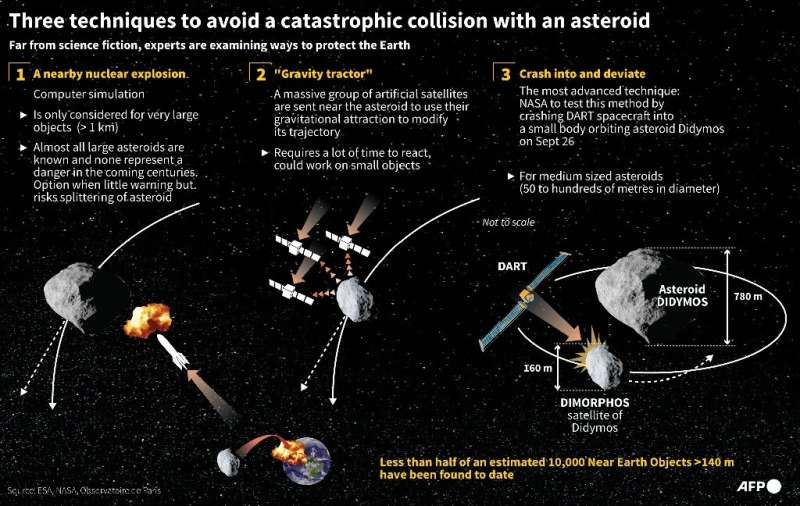Direct impact or nuclear weapons? How to save Earth from an asteroid

Graphic showing three techniques being considered by scientists to avoid a catastrophic collision between Earth and an asteroid as NASA crashes the DART spacecraft into a mini-asteroid on Monday.
NASA’s DART mission to test the deflection of an asteroid by “kinetic impact” with a spacecraft is just one way to protect planet Earth from an approaching object — and for now, the only method possible with current technology.
The operation is like playing billiards in space, guided by Newton’s laws of motion.
If an asteroid threat to Earth were real, a mission might need to be launched a year or two in advance to combat a small asteroid, or decades ahead of the planned impact for larger objects hundreds of kilometers across that could prove catastrophic to the planet planets could prove .
Or a larger object might require hits from multiple spacecraft.
“This demonstration will begin to add tools to our toolbox of methods that might be used in the future,” Lindley Johnson, NASA’s Planetary Defense Office, said in a recent briefing.
Other proposed ideas included a futuristic-sounding “gravity tractor” or a mission to blow up the hypothetical object with a nuclear weapon – the method favored by Hollywood.
gravity tractor
Should an approaching object be detected early—years or decades before it would hit Earth—a spacecraft could fly alongside it long enough to redirect its path, using the ship’s gravitational pull and creating what’s known as a gravitational tractor.
This method “has the advantage that the method of moving the asteroid is perfectly well understood — it’s gravity and we know how gravity works,” said Tom Statler, a scientist with NASA’s DART program, at a briefing last November when DART was launched.
However, the spacecraft’s mass would be a limiting factor – and gravity tractors would be less effective for asteroids larger than 500 meters in diameter, which are the biggest threat right now.
In a 2017 paper, NASA engineers proposed a way to overcome this snag: by having the spacecraft scoop material from the asteroid to increase its own mass, and thus gravity.
But none of these concepts were tried and it would take decades to build, launch and test.
Nuclear detonation
Another option: fire nuclear explosives to deflect or destroy an asteroid.
“This may be the only strategy that would be effective for the largest and most dangerous ‘planet killer’ asteroids (more than a kilometer in diameter),” says a NASA article on the subject “last resort” if the other methods fail.
But these weapons are geopolitically controversial and technically banned for use in space.
Lori Glaze, director of NASA’s Department of Planetary Sciences, said in a 2021 briefing that the agency believes the best way to deploy the weapons is at a distance of an asteroid to apply force to the object, without blasting it into smaller pieces that could then multiply the threat to Earth.
A 2018 paper published in the Journal of Experimental and Theoretical Physics by Russian scientists looked at a direct detonation scenario.
E. Ju. Aristova and colleagues built miniature models of asteroids and irradiated them with lasers. Their experiments showed that blowing up a 200-meter asteroid would require a bomb 200 times more powerful than the one that exploded over Hiroshima in 1945.
They also said the most effective way was to drill into the asteroid, bury the bomb, and then detonate it — just like in the Armageddon movie.
NASA will crash a spacecraft into a 525-foot-wide asteroid in September. Here’s how to watch it
© 2022 AFP
Citation: Direct Impact or Nuclear Weapons? How to save Earth from an asteroid (2022, September 26) Retrieved September 26, 2022 from https://phys.org/news/2022-09-impact-nuclear-weapons-earth-asteroid.html
This document is protected by copyright. Except for fair trade for the purpose of private study or research, no part may be reproduced without written permission. The content is for informational purposes only.